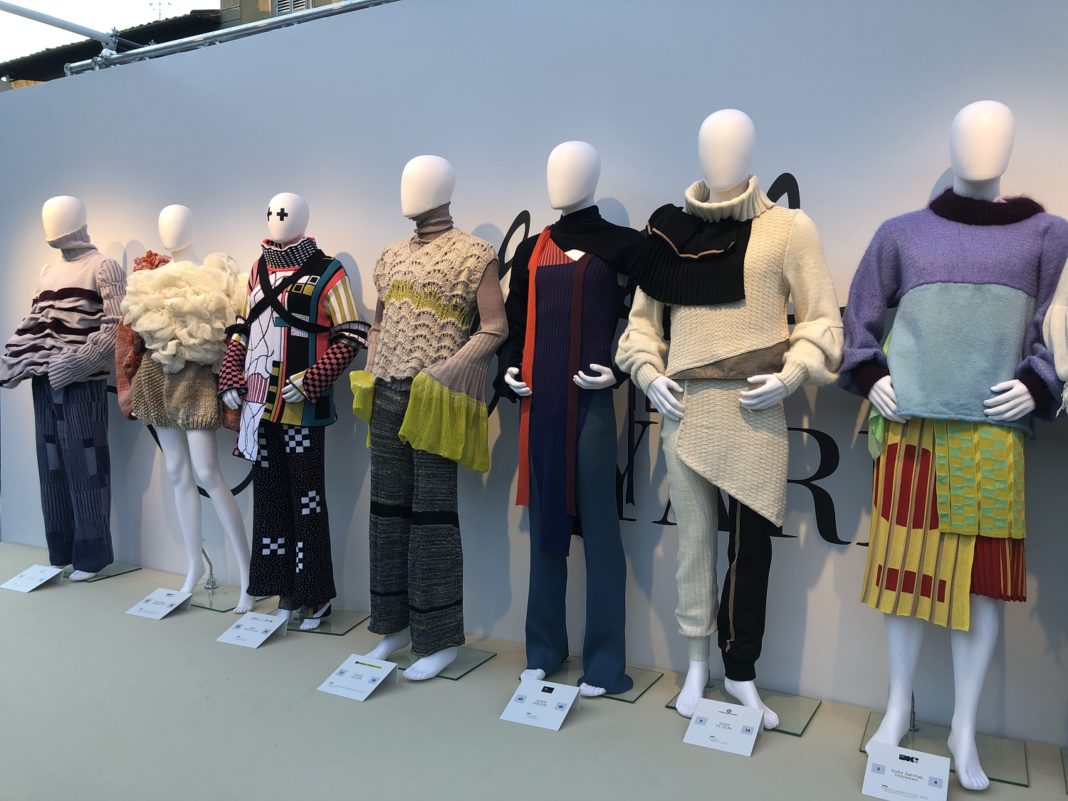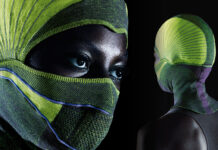Most exhibitors at Pitti Filati yarns for 2020-2021 had a natural element to their collections, or went all out for natural, contemporary looks using muted shades and undyed yarns to soften the tone and soothe the soul.

It revealed that the industry is moving on from vague statements of responsibility and sustainability to spending money on working to conserve materials better, measuring progress against targets and fulfilling the requirements of GOTS and OCS.
Sustainability credentials
The Pitti project on sustainability included a broad definition from production through a sustainable chain to the use of biological raw materials and the salvage of pre or post-production waste from factories. A special Pitti project Young Talents for Sustainable Thinking by Salvatore Ferragamo, showcased the work of students from eight different school from Helsinki, Rome, Tokyo, Shanghai, Florence, London, New York and Milan, where students created accessories or clothes from sustainable of recyclable materials donated by Ferragamo to each college judged by a panel of fashion professionals and put on show at the fair.

Natural colours and unusual qualities follow from the prevailing eco interest; natural fibres spun for a cloudy look and a soft fleecy touch, puffy and voluminous; E Miroglio, Zegna Baruffa and Crabyon (from shells) at Biella Yarn. Todd & Duncan introduced a brand-new Undyed Cashmere collection in natural colours to join their colour cards. Zegna Baruffa introduced Chlorine-free colours and metal-free dyeing. Marchi & Fildi pioneers of Ecotec yarn and the principles of the circular economy at Pitti Filati mix old and new fibre.
1980s revisited
A mixture of bright colours shine and sparkle with paillettes and metallics made a funkier approach. Cult knitwear from the 1980s was displayed at Pitti Filati in a major display of the then internationally known brand Pour Toi, by architect Luca Coelli and American artist/embroiderer Sam Re lent by Modateca Deanna.

Many features of the era already appear in exhibitor collections. This year Heritage at the Spazio Ricerca was looking both backwards and forwards, incorporating new yarns and craft techniques, the whole designed by Figus and Miller, while CustomEASY brought denim style customisation to individualise luxury knitwear.
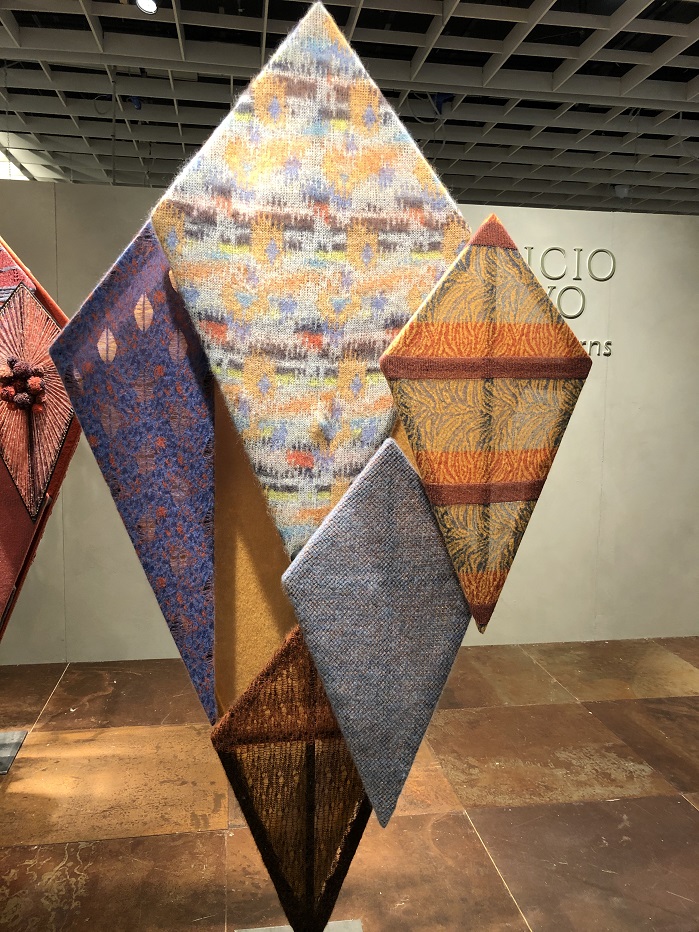
Bright colourful shiny elements were designer favourites; Ilaria, Chiavazza or glossy viscose at Filidea. Lineapiu with multicolour metallic flashes, holographic elements for fringing and 3D yarns with jewel effects under lights. Botto Giuseppe’s metallic reflection, Cariaggi varying sequin density to alter the shine as the customer decrees.

Mohair was key this season , luxurious and natural ,seen in arresting garment form at Ilaria, the fibre chosen for many collections. Bright tweed yarns are still in demand, as at Knoll and Mister Joe. New yarns included 3D s like Lineapiu’s Lumen, photosensitive viscose yarn, or paper knit at Filpucci.
Knit Club Bespoke attitudes
Labels and knitwear designers work closely with spinners to develop their fabrics; many choosing optional eco-dyes as at Zegna Baruffa or specialised dyeing to express a signature like Cariaggi.
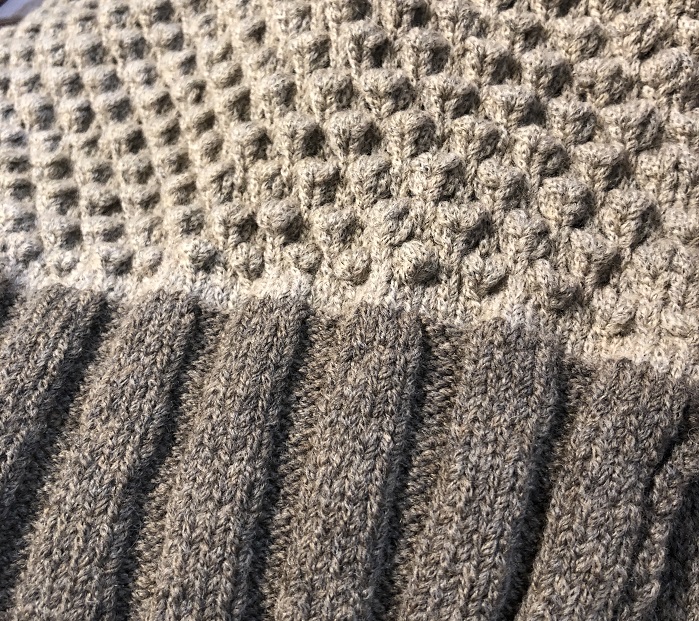
Knit Club features high-class, high value knitwear manufacturing. Companies are picked for their ability to interpret and carry out the technical needs and ideas of customers. visitors, from yarn developers to manufacturers, designers and buyers as well as the style bureaux visit the knit manufacturers who have seen real results since the manufacturers have been added to the mix, this year including some Japanese and Australian companies.
Upcycling and re-use
Efforts to establish re-use and re-purposing are an important step forward in this edition of Pitti Filati. Recycled wool and polyester, e.g. Re. Verso polyester at Filpucci . Marchi & Fildi’s Ecotec with upcycled post-consumer raw materials, treated and renewed and blended with new fibres. with a mixture of bright colours and a measure of shine and sparkle for a more funky approach. Pinori described themselves as ‘reducing plastic with organic thought’ introducing a recycled cotton and polyester yarn.

Biella Yarn, Sudwolle, introduced yarn made from recycled materials as an integral part of the offer; Monsone 2/28 100% Merino recycled, Maple 2/30-2/48 60% extra fine Merino, X-Care/40% recycled polyester. Filclass Re-Fashion collection used discarded fibres and overstocked materials and garments made into new material, inspired by creative recycling with fancy yarns with a modern look for seasonless knits. A core of contrasting recycled neon polyester, and Recycle fancy yarn made up by a mix of materials colour and structure; a mixed look made by casual assembly.
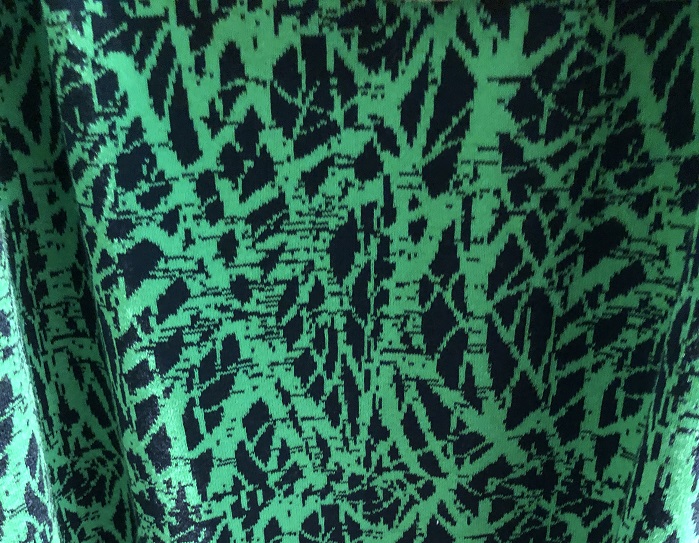
Cotton, mostly with certificates or assurances of sustainable production, including the Better Cotton Initiative also its presence felt, and linen is now a winter fibre, blended with animal fibres.
New directions
Iafil showed Ceramic Pimawool made of Pima cotton and wool with manmade ceramic crystal thread, absorbing UV-A and –B rays as a skin barrier, and thermal insulation allowing retention of body heat. Elasticised viscose for sportwear still evolving as a genre.

Tollegno 1900 enthusiastically presented technology to bring together innovation and green attitudes, with Washing Balls and Brushing Balls by Sergio Sala which claim to ensure zero impact washing and finishing. The washing balls are small spheres containing high magnetising neodymium which move around in the water generating deodorant and natural detergent, carbon Bicarbonate. It means lower use of Detersives, lower temperatures, no deposits or chemical aids for cleaning the tumbler.

Stoll showed spectacular 3D effects and referenced trad-African tribal dress with fabrics draped on a model mannikin as avant-garde fashion, accompanied by the extraordinary speed of machines knitting complete garments on the stand.
Tollegno 1900 harnessed the power of technology with Shima Seiki machines turning out stylish wool mittens at a tremendous speed in directional colours of wine and mustard, the potential appreciated by cold fingered visitors even in outside temperatures of 37oC.

Feel the Yarn, in its 10th year, grows ever more important for budding designers from around the world, this year from 27 countries, all with a high degree of skill and imagination using exhibitors’ luxury yarns. Winner overall this year, Camilla Conti of Polimoda, Florence.

Subscribe To Our Newsletter
Join our mailing list to receive the latest news and updates from our team.


